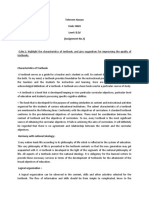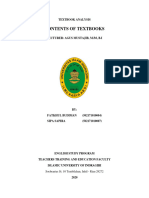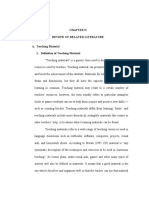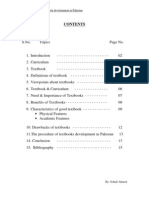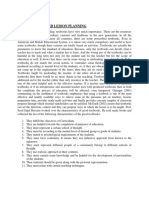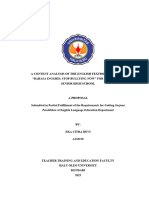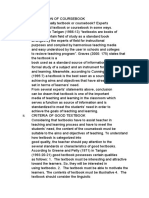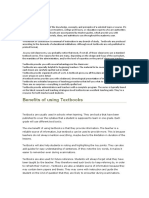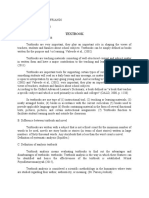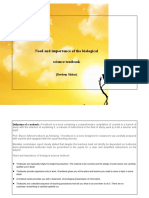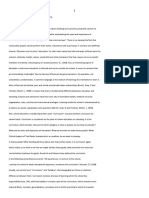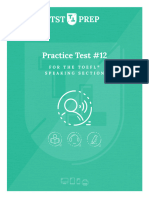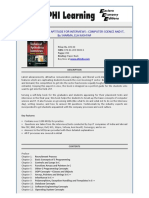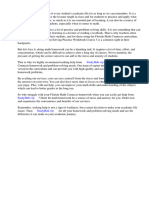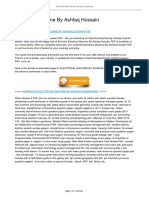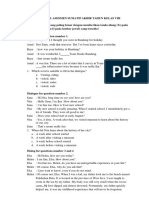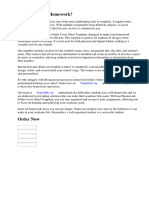UNIT - 25 ❐ TEXTBOOK AS AN INSTRUCTIONAL
AID
Structure
25.1 Introduction
25.2 Objectives
25.3 Textbook
25.3.1 Meaning and Importance
25.3.2 Characteristics of Textbook
25.3.3 Uses of a Textbook
25.4 Let Us Sum Up
25.5 Answers to ‘Check Your Progress’
25.6 Unit-End Exercises
25.7 References
25.1 Introduction
You know that, every teacher wants to give a very effective learning situation to
the students. Therefore apart from just presenting or imparting the information orally,
a teacher goes in search of other resources and aids that facilitate learning. In this
context, the ‘textbook’ takes up a very conspicuous role. Though the textbook does not
reflect the whole curricular programme, it is considered as almost an inevitable and
integral part. A teacher may feel that, he or she is incapable of teaching in the absence
of textbook. It is true that, in most of the time, the textbook serves as a guide to the
syllabus or becomes the syllabus. Other supplementary reading books, periodicals,
newspapers, science journals, work books, laboratory manuals, teacher’s guide, etc.,
also facilitate the teaching - learning process. In this particular block, you will come to
know about the prominent Instructional Aids.
Usually, in any education system, the objectives will be constructed at the first
step. These objectives will be the means to achieve the broader educational goals and
aims. Based on the objectives, curriculum will be designed and this will be followed
by syllabus construction. Syllabus gives the whole curricular idea in a brief and precise
language. Most of the time, the syllabus is equated with a telegraphic message! Whatever
323
�that is told in the syllabus in terms of broken sentences will get the relevant expanded
form in a textbook. Let us concentrate on the meaning, nature, importance, characteristics
and advantages of a textbook.
25.2 Objectives
After studying this Unit, you will be able to:
¾ Explain the meaning of a textbook
¾ Understand the importance of a textbook
¾ Identify the characteristics of a textbook
¾ Learn the uses of a textbook.
25.3 Textbook
A textbook is considered as a synonym to syllabus. In any school system, you will
come across three to four types of textbooks. That is to say, all the languages - whether
it is first language, second language or third language will have their own specific
textbooks. The students are supposed to study three languages through the three
respective textbooks. Similarly science textbook and social science textbook are also
there. They could be printed in any medium i.e language according to the requirements
of studies. So, totally there will be the respective textbooks for three languages and
three core subjects at the school level.
The textbook practically describes what should be taught. Therefore, while
prescribing, writing, and selecting a textbook one must be highly cautious. The textbooks
are used chiefly as a source of information, a course of study, a set of unit plans and a
learning guide as well.
25.3.1 Meaning and Importance
Though textbooks are inevitable to teachers now-a-days it is extremely important
on their part to think about the general problems of the textbook, its functions,
characteristics and the methods of using it.
The present-day textbook is usually divided into sections which are again sub-
divided into chapters. Hence, it is perceived that a textbook is a course of study which
may be used in its entirety. A textbook invariably begins with an introductory section,
which sets the stage for the whole year’s programme. The chapters are arranged
324
�sequentially with a natural continuity of information and give a solid structure for the
classroom academic activity. Along with the printed information, you could see the
photographs and drawings. Each chapters may have several suggestions for
supplementary activities, like, experiments, demonstrations, readings, long term
activities, and short term activities etc;
Few textbooks, supplement the information with materials in boxes, or with
footnotes. The boxes may also contain biographical sketches of scientists or of some of
historians or of some great personalities. Sometimes, you may come across a section
on glossary. Usually a textbook provides a provision for self evaluation. Anyhow,
textbooks tend to be general and comprehensive. They are written for nationwide sale
and therefore deal only with topics of national interest.
All these points explain the meaning and nature of a textbook in general. Now let
its try to focus on the importance of a textbook. The main function of a textbook is to
provide the body of knowledge. It is hence a strong teaching-learning bond between
the teacher and the taught.
As it is already pointed out, it is an extended form of the prescribed syllabi. That
is to say, it is a verbal explanation of the highly abbreviated syllabus. It is a very good
and sound basis for the teacher to generate several learning activities. Through chapter-
end exercises, it gives a scope for self-evaluation to a learner as well as to a teacher.
‘Check Your Progress’-1
Fill in the Blanks
1. The textbook, most of the time plays the role of …………. ( Notes, teacher, syllabus,
student)
2. The textbook is one of the .......................................(instructional aids, books, printed
materials, written documents)
3. A textbook contains ........................at the end of each chapter.
(Self evaluator questions, pictures, photographs, graphs)
25.3.2 Characteristics of Textbook
Now, if you ask a question to yourself, like “what types of textbook you want?”,
then you will list out all the good characteristics of a textbook. Isn’t it? So, come on,
now, let us do the same task. The characteristics of a good textbook are as follows:
• Textbooks are always in accordance with the aims and objectives of educational
system.
325
�• Textbooks provide a scope for the development of certain skills. Their skills may
vary with the subjects, like, languages and the core subjects, namely, science,
social science and mathematics.
• The textbook should have good external internal features also. External features
(also known as the mechanical features are nothing but, get up, the quality of the
paper, the printing, photographs, graphs, binding, background sets, etc; - All these
should be attractive and mind catching.
• Internal features are, like, the standard and the method of treatment and presentation
of the subject matter, clarity in the language used, accuracy of the facts, concepts
and principles mentioned, the quality of the supportive diagrams etc.
• The subject matter should be presented in a psychological sequence. It has to
catch the attention of the students, develop interest among them.
• The information within the textbook should reflect the essential criteria, namely,
consistency, reality, etc., It should stand as a device to inculcate certain values,
like, open mindedness, scientific attitudes, scientific method and disciplinary values.
• It should give a chance for the students to carry out certain projects or activities by
good suggestions, so that pupils can understand the subject matter in a better way.
• Each chapter should begin with a brief introduction and end with a fitting summary.
• Each chapter should contain assignments at the end of the chapter with a due
scope for different level of learning, namely, knowledge, understanding, application
and skill.
• All captions and sub-captions must be bold type. The matter should be presented
suitably with a varied and distinctive form.
• Each textbook should be made up of three essential parts, namely
i) Preliminary section
ii) Chapter
iii) Reference Section.
Under preliminary section, it should give the details of sponsoring agency,
government officer, publishers, authors, table of contents and figures. In chapter’s
section, the subject matter has to be printed according to the principles and maxims
of the teaching. In the reference section, glossaries, appendixes must be present.
• The language used in the textbook must be lucid, simple and precise one. It should
326
� be free from ambiguity, use of double negatives in a sentence etc;
• It should suggest quite a good number of learning activities. It should be in such a
way that, it draws the social community resources and school -society interaction.
• Textbooks of different subjects must bring a strong and positive correlation among
science, craft, social environment and physical environment.
• Each textbook should be accompanied by a teacher’s hand book, work book and
laboratory manuals. (for the science subject).
• The content should be appropriate for the age level and experience background of
the pupils. The concepts should not be too complex for the maturity level of the
pupils.
• The contents should be consistent with the general objectives, goals and aims of
the respective curriculum.
As far as the literary style and vocabulary is concerned, following points have to
be taken care of by the author.
a. Length of sentences
b. Directness of sentences
c. Number of ideas per sentence
d. Continuity of thought.
• The text should have sufficient number of illustrations, clear photographs diagrams,
like, they must be eye-catching.
• The activities at the end of each chapter are to be in such a way that it should meet
the needs of the teacher and the taught.
• A textbook should help to reinforce learning that might have originated in the
class room or laboratory or on the field trip or outside of school. Such reinforcement
should come from self-study and assignment works.
In a nut shell, one can say that, a textbook should be assessed by means of its:
1) Correctness of matter: The subject matter presented in the book must satisfy these
criteria by means of accurate, correct, integrated information.
2) Language and communication: A textbook language must be simple, clear and
lucid in preference. It is good, if the regional textbooks, give the English terminology
within the brackets for certain technical terms.
327
�3) Simplicity of Diagrams: The diagrams presented in a textbook must be well labeled,
with good proportion in size, so that; students can read the labels comfortably.
Moreover, the diagrams and sketches must be self explanatory, with a bold heading
and relevant foot notes.
4) Quality of Printing and Binding: The paper used to print the contents must be of
a good quality. The binding must give a good get up to the text. The printing also
should be appealing. The subject matter should be sequentially and psychologically
arranged. Headlines and Sub-head lines should be discriminated by a proper ‘font-
size’ and bold letters. It should contain a table of contents at the beginning and a
subject - index at the end. If it is a science textbook, then glossary of some important
scientific terms at the last part of a textbook is a must. So, a good text - book
should satisfy at the above said points as far as possible.
‘Check Your Progress’- 2
State whether the following statements are True / False:
1. One of the external features of a good textbook says that, it should have a very
attractive get up.
2. The difficulty level of the subject matter in a textbook must be very high.
3. Textbooks help in the formation of goals and aims of a curriculum.
4. There is no need to critically analyse a textbook.
5. The textbooks should have clear explanation good illustrations, appropriate
vocabulary and a good writing style.
25.3.3 Uses of a Textbook
If a textbook satisfies most of the criteria which are listed already, then, it will be
very advantageous to both the teachers as well as the students. So, now let us list
out the uses of a textbook.
• In most of the time, the textbook serves as a guide to the syllabus or constitutes the
syllabus itself.
• It is also true that, a textbook enriches the syllabus, through suggested activities
and suggested readings.
• The primary use of a textbook is that, it is used as one of the instructional aids in
terms of reference, by the teacher as well as the students.
328
�• It reinforces the learning that might have been occurred in the class room or the
laboratory.
• Textbook, gives the ideas for home assignments, which could be effectively used
by a teacher. The exercises at the end of the each chapter help for giving the drill
work to the students.
• Since textbooks are developed with the common goals and objectives at the national
level, thus they are the best devices in bringing national integrity.
• Textbooks facilitate individualized instruction.
• They are very cheap, economical and accessibility to the users.
• They encourage self-evaluation as well as self - directed activities.
• It will be the major source of information for the students to get prepared for the
examination.
• A textbook knowingly or unknowingly, directly or indirectly keeps the school
activities on a track
• Textbooks are the major source for developing ‘reading - recitation techniques’. -
Here, as the term itself is suggesting, the pupils read a section of the textbook and
then recite their learning. But it should not be overdone.
• A teacher may delegate to a group of pupils, the responsibility for presenting a
section of a textbook unit to their class mates. This is called “pupil presentations
of textbook material”.
• Reading assignments could be given to the students, based on the textbooks.
• Textbooks give quite a good number of illustrations. It also provides many
photographs and diagrams, which could be used for extended discussion and for
further applications.
• Textbooks are also used for summary and review; this is considered as one of the
strongest uses of the textbook
.
‘Check Your Progress’-3
1. The textbook must be assessed from two points of views, they are its
a) Pictures and diagrams
b) Printing and chapter end exercises
329
� c) Table of contents and index
d) External or mechanical features and internal features
2. The instructional material which forms a strong bond between the teacher and the
taught is
a. Textbook
b. Teacher’s guide
c. Work books
d. None of the above.
3. A textbook must be
a. Attention catchy
b. Very light
c. Loaded with information
d Bulky enough
4. Write any two uses of textbooks.
25.4 Let Us Sum Up
Textbook is the most inevitable and integral part in teaching profession. It is
considered as the most important instructional aid. It is an extended form of the whole
syllabus of an academic year. A textbook will be constructed in ccordance with general
aims, goals and objectives of a curriculum. Textbooks are there for three languages and
for three core subjects namely, science, social science and mathematics at secondary
school level. A textbook is the source of information, which throws light on what
should be taught. There are certain criteria, based on which a textbook has to be selected.
Usually textbook will be very general and tend to be comprehensive. Textbooks are
written for a national curriculum. The textbook gives an opportunity for the development
of certain skills, namely, communication skills through language textbooks, observation,
hypothecation and problem solving skills through the science, social science and
mathematics textbooks.
A typical textbook must satisfy the criteria of external or mechanical features as
well as internal features. Outward get up, its binding, quality of the paper, colour - etc;
constitute the external or mechanical features of a textbook. Similarly, the subject matter
330
�presented inside the textbook, the accuracy, clarity, of the information, its consistency,
clarity in sketches, and diagrams, lucid, simple, meaningful sentences etc; all these
constitute the internal features.
To have a good textbook in an educational system is really advantageous as it is
used in several ways. Most of the times it serves as a guide to the teacher, by enriching
the syllabus. It makes a pupil to get prepared well for the examination. They are the
best devices in bringing national integrity. Based on the textbook exercises a teacher
can design several drill works as well as an array of home assignments.
25.5 Answer to ‘Check Your Progress’
‘Check Your Progress’ - 1
1. Syllabus
2. Instructional aids
3. Self-evaluatory questions
‘Check Your Progress’ - 2
1. True
2. False
3. False
4. False
5. True
‘Check Your Progress’ - 3
1. d) External or mechanical features and internal features
2. a) Text book
3. a) Attention catchy
4. Write any two used from section 25.3.3
25.6 Unit-End Exercises
1. What is a textbook? Explain its meaning and importance.
2. Explain the need of a textbook
331

